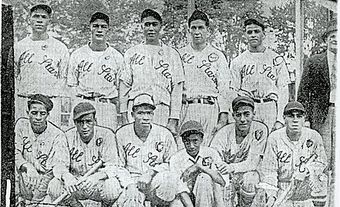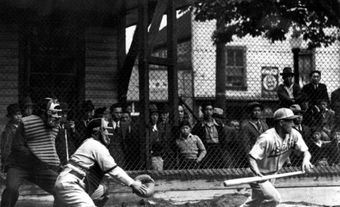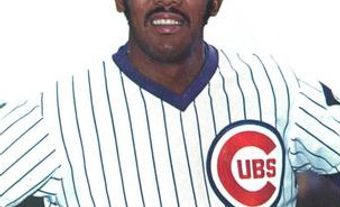William “Hipple” Galloway, baseball player, hockey player, tinsmith (born 24 March 1882 in Buffalo, New York; died 17 February 1943 in Buffalo). Raised in Dunnville, Ontario, William Galloway became the first Black Canadian to play professional baseball when he started at third base for the Class-D Canadian League Woodstock Bains on 12 June 1899. He was also one of the first Black Canadians to play amateur hockey in Ontario. Galloway was inducted into the Canadian Baseball Hall of Fame in 2021.

Early Years
William Galloway was born in Buffalo, New York. According to Richard Armstrong’s biography of Galloway in the 2022 book, Our Game, Too: Influential Figures and Milestones in Canadian Baseball, Galloway’s mother was Julia Sims. His adoptive father was William Galloway, who lived in Dunnville, Ontario, about 40 km west of Buffalo.
Starting in 1888, Galloway went to school in Dunnville, where he developed into a standout athlete on racially integrated teams. By 1897, he was a star outfielder/third baseman for the local Dunnville BBC. The Dunnville BBC was a strong independent baseball team that competed against neighbouring towns. At the end of the 1897 season, the Dunnville Chronicle declared them to be the amateur champions of Canada.” The paper also noted that Galloway was their most popular player.
Baseball Career
In 1898, the Dunnville squad graduated to the independent professional ranks. William Galloway, who could play third base, shortstop and centre field, was one of the few locals on the team. It was comprised largely of imported professionals.
The Dunnville team played high-calibre baseball. On 24 June 1898, the speedy Galloway and his teammates were beaten 1–0 by a Chatham squad that featured future hall-of-famer Rube Waddell on the mound. But despite their strong play, the Dunnville team’s home games were poorly attended. With the team struggling financially, Galloway departed to join the Woodstock Bains at the end of June.
The semi-pro Bains were part of a three-team Brantford and Woodstock League. Galloway debuted with the Bains on 1 July 1898; he was their third baseman in both games of a doubleheader. After a shaky debut defensively, Galloway rebounded and stole three bases the following day. On 23 July 1898, he hit his first home run with the Bains. Galloway and the Bains were so dominant that they clinched the league title by mid-August.
Galloway returned to the Bains in 1899. On 9 June, the Stratford Poets withdrew from the Class-D Canadian League and the Bains replaced them. Three days later, Galloway and the Bains travelled to London, Ontario, to take on the local Cockneys Club. Galloway started at third base and became the first Black Canadian player in Organized Baseball (MLB and all levels of its affiliated minor leagues). According to Armstrong’s biography, Galloway was flawless in the field and singled in the fourth inning to record his first pro hit in an 8–3 loss.
The Bains lost again to London the next day, then dropped two games to the Chatham Reds with Galloway in their lineup. However, in the next road game the Bains played, against the St. Thomas Saints, Galloway was subjected to racist taunts from the crowd and made three errors. The Bains released Galloway the next day. In five professional games, he had three hits in 20 at bats, but that wasn’t the only reason for his release. Some players from other teams in the Canadian League had made it known that they would not play against him.

Galloway then signed with the Woodstock City Club, where he had four hits, two runs and four stolen bases in his first game. Later in the season, he played three exhibition games against the Bains, his former club, and showed off his versatility by playing first base, shortstop, left field and centre field.
In the spring of 1900, he joined the Cuban X-Giants, a dominant Black independent team. They travelled across Canada and the US playing exhibition games. According to Armstrong, Galloway was a “serviceable third baseman” and a “reliable singles and doubles” hitter for the Giants. Galloway continued to play for them through the 1906 season.
Hockey Career
After his baseball season with the Bains in 1898, William Galloway joined Woodstock’s team in the new Central Ontario Hockey Association, part of the Ontario Hockey Association (OHA). The speedy forward played his first game on 20 January 1899. Galloway, along with Charlie Lightfoot, who skated for the Stratford team in another OHA league, became two of the first Black players in the OHA.
Few details exist about Galloway’s hockey career. For his 2004 book A Sporting Chance: Achievements of African-Canadian Athletes, William Humber uncovered a reference to a two-goal night Galloway had against Hamilton. Humber also shares a glowing report of Galloway’s play from the 2 February 1899 issue of the Woodstock Sentinel Review: “Galloway is a right good sport and thoroughly game player. He withstood all kinds of punishment in Hamilton last week and fairly won his spurs.”
Galloway was also known for his speed. “Galloway on the forward line was also conspicuous,” reads a sentence in the Brantford Expositor’s 13 March 1889 issue. “He is a fast skater and his rushes down the sides were a feature of the game.”
Unfortunately, when Galloway attempted to return to the Woodstock hockey team after the 1899 baseball season, he was deemed ineligible because he was considered a professional athlete for the five games he had played with the Bains. According to Armstrong, Galloway played in Wingham, Ontario, in the Northern Hockey League beginning in the fall of 1904. He helped lead the team to back-to-back championships.
Personal Life
Galloway likely met his wife, Gladys Dancey, who was from Hamilton, Ontario, in early 1902. The couple settled in Woodstock, Ontario, and had seven children. In 1908, an Industrial Institute opened in Woodstock, and Galloway landed a position as a labourer. According to Armstrong, Galloway resided in Woodstock until “at least March 1914.” By 1921, he had relocated to Hamilton and found work as a machinist. He later moved again to Buffalo, New York, where he worked as a tinsmith prior to his death at age 60.
(See also Trailblazing Black Canadian Athletes; Jackie Robinson and the Montreal Royals; Manny McIntyre; Chatham Colored All-Stars.)
Honours
- Inductee, Canadian Baseball Hall of Fame and Museum (2021)

 Share on Facebook
Share on Facebook Share on X
Share on X Share by Email
Share by Email Share on Google Classroom
Share on Google Classroom






